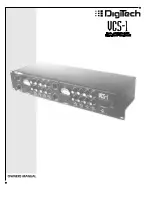
APPLICATION NOTES
Compression
Vocals:
Unless the vocalist you are recording has exceptional microphone control, some compression is
always welcome on a vocal track. A generally accepted practice, is to use a light compression ratio
of 2:1 or so when first recording the vocal to tape then, later to increase the ratio amount depending
on the density of the mix. A side effect of vocal compression is that it raises the level of lip smacks,
breathing and grunts which may be gated. Another side effect of compression is the increased level
of sibilance. You may need the De-esser function to compensate.
Drums:
Compression on drums is very effective in increasing punch without adding level or EQ. Bass drum
and snare should be compressed separately but a stereo mix of the rack toms can be compressed
together. Experiment with slow manual attack time settings and an 8:1 ratio. These settings will let
brief percussive transients through, while reducing low frequency flap. Using the Soft knee setting
will accomplish a similar effect where the beginning “tick” of a drum is passed before compression
occurs.
Bass
Bass guitar is a particularly dynamic instrument. This is especially noticeable when the Bass is
played with pop/slap technique. Without compression you can end up with peaks that distort and
low level notes that disappear in the mix. Switch in the Auto setting and start with a ratio of 4:1.
Auto is best for reducing release time chattering on sustained bass notes but you can switch to man-
ual as long as the release time is set fairly long. With higher ratios you can increase the apparent
sustain of bass notes making a nice “bed” for the rest of the mix to sit on. The sound of a pick on
roundwound strings can be emphasized by using slower attack times in manual timing mode.
Mixdown
Assuming your individual tracks were lightly or not compressed to tape, you can consider adding a
bit of overall “mastering” compression to your mixes. A note of caution though: good mastering is
done by professionals with years of experience. Be careful not to overdo it. Compression can, how-
ever help greatly when you are making cassette dubs from DAT. Cassettes cannot handle dynamics
like DAT so it’s a good idea to compress when dubbing. A good setting to start with is with Auto on
and a ratio of 2:1. The Auto setting is program-dependent and it works well with mixed program
material.
Peak Limiting
Peak limiting is an important asset during live-to-digital recording. Input levels set at the beginning
of a recording date can be exceeded as the players perform with more enthusiasm than during the
sound check. The peak limiter in the VCS-1 can be used to reduce the number of transient peaks
causing digital distortion with no effect on dynamics below the threshold.
•••
9
•••
Содержание VCS1
Страница 1: ......
Страница 5: ...Connection Examples The following diagrams show a few ways in which the VCS 1 can be used 2...
Страница 15: ...12...
Страница 18: ...15 DIGITECH VCS 1 SIGNAL FLOW DIAGRAM One Channel Only...
Страница 19: ...Printed in the USA 18 2202 A...




































